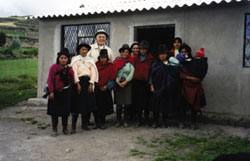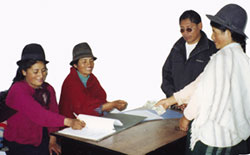Development that empowers
Having a voice in their economic development and focusing on their needs and rights enables Andean women to better their lives and their communities
By Fr. Charles Gervais, S.F.M.
September/October 2007
Return to Table of Contents
Print Article
I was only in Riobamba a short time when it became known that I was willing to help rural Andean women in their development efforts. As a 68-year-old Canadian missionary priest from a farming background, with a lifetime of pastoral work in rural areas, I knew well the unenviable condition and poverty of these women. In this new assignment in the central highlands of Ecuador, I felt a call to support the poorest of the poor – the Andean women of the Diocese of Chimborazo. Indeed this would be development that focuses on the needs and rights of women, that gives voice to women.
 Standing proudly in front of the new women's centre in Quatro Esquinas, Ecuador. With them is Scarboro missioner Fr. Charlie Gervais who is giving support to this and other economic projects undertaken by Kichwa women in nearby mountain communities. Less than a decade ago Andean women were illiterate and unorganized. Today they are empowered, having their own organizations, managing their own economic projects and administering their own credit unions, ensuring that money is available at planting time and for emergencies.
Standing proudly in front of the new women's centre in Quatro Esquinas, Ecuador. With them is Scarboro missioner Fr. Charlie Gervais who is giving support to this and other economic projects undertaken by Kichwa women in nearby mountain communities. Less than a decade ago Andean women were illiterate and unorganized. Today they are empowered, having their own organizations, managing their own economic projects and administering their own credit unions, ensuring that money is available at planting time and for emergencies.
There is a saying: "One step by a thousand people is better than a thousand steps by one." This means that ideally all members of a community or group should be going ahead together step by step in solidarity. In the Andes this solidarity is best expressed in a group of women working in a minga (community bee) to build something for themselves.
Before I could begin to help them, I felt I had to improve my Spanish and learn more about their culture. A visit from an indigenous Kichwa man and his wife confirmed this. When they arrived at our house at seven one morning, I offered them a cup of coffee. I wanted to offer them bread as well, but Ignacio Pinedo, the seminarian I was living with, reminded me that we had none. Someone had given us an angel food cake the evening before and we had eaten two slices for dessert. So we put the remaining cake on the table in front of our early morning visitors and gave them each a slice. After we finished talking, they got up to leave, but not before the woman pulled a plastic bag from her pocket and put the rest of the cake in it.
Ignacio was in his room when they left so I shouted to him, "Ignacio, they stole our cake!" We learned later about the Kichwa custom that whatever food is put in front of you when you are visiting is considered yours. If you cannot eat it all, you are expected to take it with you. Ignacio and I had a good laugh about that.
In my first year in Riobamba, I helped build a classroom in the little village of Quatro Esquinas. Shortly after finishing the classroom, the president, secretary and treasurer of a women's group in this same village came to see me. The group had been organized by a diocesan worker, but they had no place to meet. I had a fund made up of donations from my family and friends in Canada to be used for the poor. So I asked the women to invite me to their next group meeting.
At that meeting, we talked about a project to build a women's centre. We agreed that the women would be responsible for the gravel and sand and I would pay for most of the other materials needed. They would do all the construction work in mingas under the supervision of an experienced builder who was paid a salary.
A contract was signed in the presence of all the group members and their centre was built. During the blessing of this women's centre, I gave them a picture of my sisters, sisters-in-law and nieces, who are many. The photo was taken the summer before when we were at our family reunion in London, Ontario. A lot of the money for this project had been raised at an auction during that reunion. The women hung this picture in the centre alongside a picture of the members of their group: women in Canada reaching out to women in Ecuador.
 Welcoming a new member to their women's group.
Welcoming a new member to their women's group.
The second centre for women that I helped build was in a community called Gallo Rumi about an hour and 15 minutes drive up a narrow mountain road from Riobamba. During the blessing of this centre, there was a meal prepared for all the people of the community. The highlight of this celebration was when the village captain presented the keys of the new centre to Maria Sebastiana, president of the women's group. For this region, this was a significant recognition by the men of the increasing liberation of the women.
The third and largest women's group that I cooperated with live in a place called Pulingui Centro. There were 45 members. They had already bought two pieces of land with money collectively earned by selling their handicrafts, and by making and selling compost fertilizer with worms to speed up decomposition.
Every Monday morning, the women would go to their land to work together on their communal vegetable and herbal garden.
Again there was a contract of agreement signed and we started to build. As we were working on the second story, we had a meeting and I told the women that all I had left was $2,000, which was not enough to complete the building. I said I would release the money when they too raised money for this project. By now, the group's members had grown to more than 80 with the possibility of there being as many as 200 in this area.
Soon after, they called me for another meeting and the president pulled out of her pocket more than $800. Newcomers to the group had been asked to donate $20 each to help with the building. With this money we were able to complete the project.
Now the women have a place to meet, a place to celebrate and a place to share communal meals. They also use the centre for craft activities, selling their beautiful handicrafts to tourists. The centre is also a place of learning. Female lawyers come as volunteers to teach the women about their rights. Lectures on self-esteem are also available to them. Many of these women do not know how to read and write and now diocesan workers have a place to teach them. As well, a group of Cuban adult educators in Riobamba, paid by the Cuban government, are willing to teach the women free of charge. There are thousands of Cuban doctors and teachers helping here in Ecuador and in other Latin American countries.
Because the women are organized – meeting, learning and working together – they get out of the isolation of their huts scattered around this farming area. This has cut down considerably on household abuse of the women by the men.
Mary as the Mother of Jesus is an inspiration to the women. Practically all of them have Mary (Maria) as part of their name. When the indigenous in the Andes first heard the missionaries speak about Jesus and Mary, they accepted our Blessed Mother. To understand this, one has to know a bit about their culture. To the Andean people, everything is symmetrical, even their music. And all of creation is balanced, male and female: the Sun (male) is the source of energy and light, and enables the Earth (female, Pachamama) to bring forth life and nurture all that sustains life. So the people understood Mary as an integral part of God's redemptive plan for creation.
It is a privilege to accompany the women of Riobamba. Like many people, I recognize that if the women of the world are empowered, the world will change for the better. This is the beginning of true development.
Return to Table of Contents
Print Article